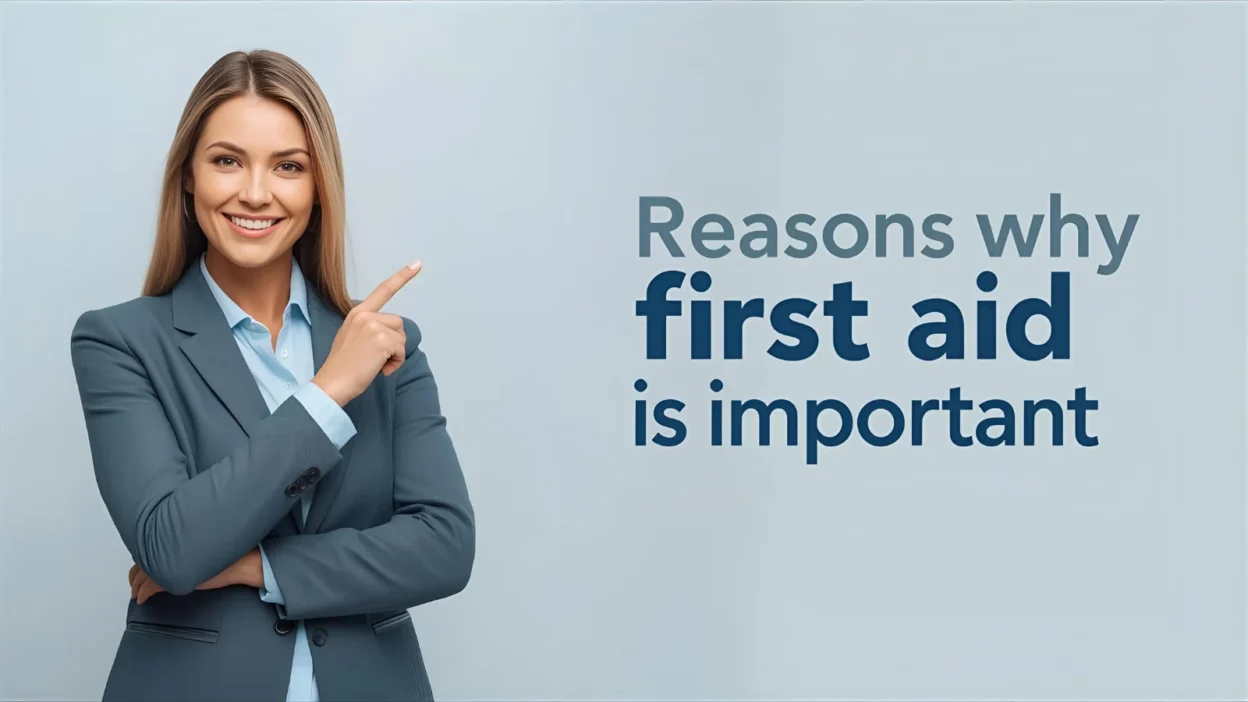Accidents and emergencies can happen anytime, anywhere—at home, school, work, or on the road. In those critical moments before professional medical help arrives, first aid can make the difference between life and death.
First aid isn’t just about bandages and antiseptics—it’s about knowledge, confidence, and immediate action. In this article, we’ll explore the reasons why first aid is important, along with examples, idioms, vocabulary, and real-life applications.
Understanding First Aid
📌 Definition:
First aid is the immediate care given to an injured or ill person before full medical treatment is available. It includes simple procedures like cleaning wounds, stopping bleeding, or performing CPR.
👉 It’s not about replacing doctors but about stabilizing someone until help arrives.
Reasons Why First Aid Is Important
- Saves lives – immediate CPR or bleeding control can prevent death.
- Reduces recovery time – early treatment helps wounds heal faster.
- Prevents complications – quick care stops injuries from worsening.
- Provides comfort – even simple reassurance calms the patient.
- Promotes safety awareness – encourages accident prevention.
- Useful anywhere – homes, workplaces, schools, and travel.
- Empowers individuals – gives confidence to act in emergencies.
- Protects children and older people – vulnerable groups need immediate help.
- Boosts community resilience – trained citizens reduce burden on hospitals.
- Strengthens workplace safety – many jobs require first aid readiness.
First Aid in Everyday Life
You may not notice it, but first aid plays a role daily:
- At home – treating burns, cuts, or choking.
- At school – teachers handling playground injuries.
- At work – dealing with accidents in offices or factories.
- On the road – helping accident victims before ambulances arrive.
- During travel – responding to altitude sickness or food poisoning.
💡 Example: A parent performing the Heimlich maneuver on a choking child can save their life in seconds.
The Science Behind First Aid
The human body can deteriorate quickly after injury. For instance:
- Severe bleeding can cause death within minutes.
- Cardiac arrest survival depends on CPR within 4–6 minutes.
- Burns must be cooled immediately to limit tissue damage.
👉 First aid bridges the gap between accident and hospital care.
Types of First Aid
- Basic wound care – cuts, bruises, burns.
- CPR (cardiopulmonary resuscitation) – for cardiac arrest.
- Fracture support – splints or immobilization.
- Choking response – Heimlich maneuver.
- Shock management – keeping patient calm and warm.
- Poisoning aid – identifying and reducing exposure.
Idioms About Aid and Help
- “Come to the rescue” – help someone in need.
- “Lend a hand” – assist someone.
- “Throw a lifeline” – give critical support.
- “Step in” – intervene during a crisis.
- “Safety net” – backup support when things go wrong.
Synonyms for First Aid
| Synonym | Example Sentence |
|---|---|
| Emergency care | She received emergency care after the accident. |
| Immediate treatment | Immediate treatment saved his life. |
| Initial assistance | Initial assistance reduced her bleeding. |
| Urgent help | He provided urgent help at the scene. |
| Basic medical aid | Basic medical aid was enough until doctors arrived. |
Grammar Note: First Aid in Use
- Noun – He learned first aid in school.
- Adjective – She took a first aid course.
- Compound term – always written as first aid, not “first-aid” unless modifying a noun (e.g., first-aid kit).
Real-Life Examples of First Aid’s Importance
- A passerby performing CPR on a heart attack victim.
- Teachers applying bandages to playground injuries.
- Workers controlling bleeding from machinery accidents.
- Travelers using first-aid kits during hikes.
- Families responding to burns from cooking accidents.
Challenges in First Aid
- Lack of training – many people don’t know proper techniques.
- Fear or panic – hesitation delays help.
- Limited resources – no first-aid kits available.
- Myths – wrong methods (like putting butter on burns) cause harm.
- Neglect – people underestimate its importance until emergencies happen.
✅ Solution: Widespread training, awareness campaigns, and accessible kits.
The Future of First Aid
- Mobile apps – guiding people step by step in emergencies.
- AI-powered devices – smart defibrillators with voice instructions.
- Virtual reality training – realistic first aid practice.
- Community programs – making first aid a life skill for everyone.
- Workplace integration – safety audits and trained staff in all industries.
🚀 First aid is becoming smarter, faster, and more universal.
FAQs About First Aid
Q1: Why is first aid training important?
Because it prepares individuals to act quickly and confidently in emergencies.
Q2: Can first aid really save lives?
Yes, immediate actions like CPR and bleeding control often mean survival.
Q3: Should children learn first aid?
Yes, even basic knowledge empowers children to help themselves and others.
Q4: What are the 3 Ps of first aid?
Preserve life, Prevent worsening, and Promote recovery.
Q5: Do workplaces need first aiders?
Yes, most safety laws require trained first aid staff at workplaces.
Conclusion
First aid is more than a set of medical skills—it’s a life-saving responsibility. It protects lives, reduces suffering, and builds safer communities. Emergencies don’t wait, and neither should we.
The strongest reason first aid is important? Because in the critical first moments of an emergency, your action can save a life.



